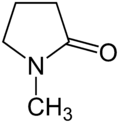''N''-Methyl-2-pyrrolidone
| |||
| Names | |||
|---|---|---|---|
| Preferred IUPAC name
1-Methylpyrrolidin-2-one | |||
| Other names
1-Methyl-2-pyrrolidone N-Methylpyrrolidone N-Methylpyrrolidinone Pharmasolve | |||
| Identifiers | |||
3D model (JSmol) |
|||
| ChEBI | |||
| ChEMBL | |||
| ChemSpider | |||
| ECHA InfoCard | 100.011.662 | ||
| KEGG | |||
PubChem CID |
|||
| UNII | |||
| |||
| |||
| Properties | |||
| C5H9NO | |||
| Molar mass | 99.13 g·mol−1 | ||
| Density | 1.028 g/cm3 | ||
| Melting point | −24 °C (−11 °F; 249 K) | ||
| Boiling point | 202 to 204 °C (396 to 399 °F; 475 to 477 K) | ||
| Soluble[1] | |||
| Solubility in Ethanol, acetone, diethylether, ethyl acetate, chloroform, benzene | Soluble[1] | ||
| log P | −0.40[2] | ||
| Hazards | |||
| NFPA 704 | |||
Except where otherwise noted, data are given for materials in their standard state (at 25 °C [77 °F], 100 kPa). | |||
| Infobox references | |||
N-Methyl-2-pyrrolidone (NMP) is an organic compound consisting of a 5-membered lactam. It is a colorless liquid, although impure samples can appear yellow. It is miscible with water and with most common organic solvents. It also belongs to the class of dipolar aprotic solvents such as dimethylformamide and dimethyl sulfoxide. It is used in the petrochemical and plastics industries as a solvent, exploiting its nonvolatility and ability to dissolve diverse materials.[3]
Preparation
NMP is produced industrially by a typical ester-to-amide conversion, by treating butyrolactone with methylamine. Alternative routes include the partial hydrogenation of N-methylsuccinimide and the reaction of acrylonitrile with methylamine followed by hydrolysis. About 20,000 to 30,000 tons are produced annually.[3]
Applications
NMP is used to recover certain hydrocarbons generated in the processing of petrochemicals, such as the recovery of 1,3-butadiene and acetylene. It is used to absorb hydrogen sulfide from sour gas and hydrodesulfurization facilities. Due to its good solvency properties NMP is used to dissolve a wide range of polymers. It is also used as a solvent for surface treatment of textiles, resins, and metal coated plastics or as a paint stripper. It is utilized as a solvent in the commercial preparation of polyphenylene sulfide. In the pharmaceutical industry, N-methyl-2-pyrrolidone is used in the formulation for drugs by both oral and transdermal delivery routes.[4] It is also used heavily in lithium ion battery fabrication, as a solvent for electrode preparation, though there is much effort to replace it with solvents of less environmental concern, like water.[5]
Biological aspects
In rats, NMP is absorbed rapidly after inhalation, oral, and dermal administration, distributed throughout the organism, and eliminated mainly by hydroxylation to polar compounds, which are excreted via urine. About 80% of the administered dose is excreted as NMP and NMP metabolites within 24 hours. A probably dose dependent yellow coloration of the urine in rodents is observed. The major metabolite is 5-hydroxy-N-methyl-2-pyrrolidone.
Studies in humans show comparable results. Dermal penetration through human skin has been shown to be very rapid. NMP is rapidly biotransformed by hydroxylation to 5-hydroxy-N-methyl-2-pyrrolidone, which is further oxidized to N-methylsuccinimide; this intermediate is further hydroxylated to 2-hydroxy-N-methylsuccinimide. These metabolites are all colourless. The excreted amounts of NMP metabolites in the urine after inhalation or oral intake represented about 100% and 65% of the administered doses, respectively. NMP has a low potential for skin irritation and a moderate potential for eye irritation in rabbits. Repeated daily doses of 450 mg/kg body weight administered to the skin caused painful and severe haemorrhage and eschar formation in rabbits. These adverse effects have not been seen in workers occupationally exposed to pure NMP, but they have been observed after dermal exposure to NMP used in cleaning processes. No sensitization potential has been observed.[6]
See also
References
- 1 2 Sigma-Aldrich Co., 1-Methyl-2-pyrrolidinone. Retrieved on 16 June 2011.
- ↑ "N-Methylpyrrolidone_msds".
- 1 2 Albrecht Ludwig Harreus, R. Backes, J.-O. Eichler, R. Feuerhake, C. Jäkel, U. Mahn, R. Pinkos, R. Vogelsang"2-Pyrrolidone" in Ullmann's Encyclopedia of Industrial Chemistry, Wiley-VCH, 2011, Weinheim. doi:10.1002/14356007.a22_457.pub2
- ↑ "Pharmasolve® Drug Solubilizer" (PDF). PharmaGuide. International Specialty Products, a division of Ashland Inc.: Page 9. Retrieved 2012-06-06.
- ↑ "Production of batteries made cheaper and safer, thanks to Finnish researchers". Science Daily. Retrieved 7 May 2015.
- ↑ Concise International Chemical Assessment Document 35: N-METHYL-2-PYRROLIDONE


